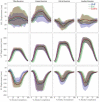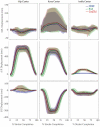Comparing optical and electromagnetic tracking systems to facilitate compatibility in sports kinematics data
- PMID: 34806553
- PMCID: PMC8635616
- DOI: 10.1080/23335432.2021.2003719
Comparing optical and electromagnetic tracking systems to facilitate compatibility in sports kinematics data
Abstract
Electromagnetic (EM) tracking has been used to quantify biomechanical parameters of the lower limb and lumbar spine during ergometer rowing to improve performance and reduce injury. Optical motion capture (OMC) is potentially better suited to measure comprehensive whole-body dynamics in rowing. This study compared accuracy and precision of EM and OMC displacements by simultaneously recording kinematics during rowing trials at low, middle, and high rates on an instrumented ergometer (n=12). Trajectories calculated from OMC and EM sensors attached to the pelvis, lumbar spine, and right leg were highly correlated, but EM tracking lagged behind ergometer and OMC tracking by approximately 6%, yielding large RMS errors. When this phase-lag was corrected by least squares minimization, agreement between systems improved. Both systems demonstrated an ability to adequately track large dynamic compound movements in the sagittal plane but struggled at times to precisely track small displacements and narrow angular ranges in medial/lateral and superior/inferior directions. An OMC based tracking methodology can obtain equivalence with a previously validated EM system, for spine and lower limb metrics. Improvements in speed and consistency of data acquisition with OMC are beneficial for dynamic motion studies. Compatibility ensures continuity by maintaining the ability to compare to prior work.
Keywords: Optical motion capture; electromagnetic motion tracking; kinematics; rowing.
Conflict of interest statement
No potential conflict of interest was reported by the author(s).
Figures







References
Publication types
MeSH terms
LinkOut - more resources
Full Text Sources
